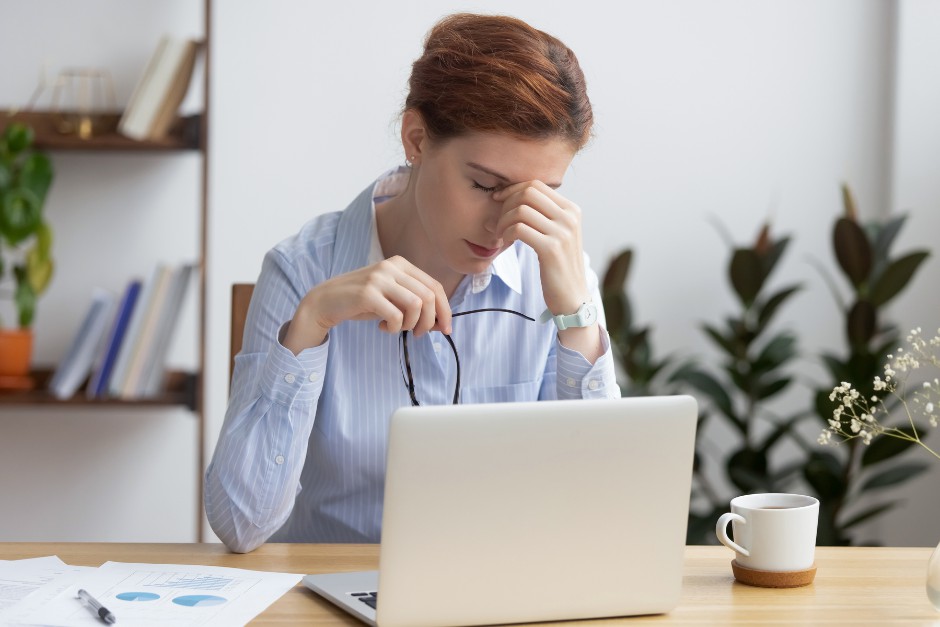Picture this: You've had a hard day at work or school, and now it's time to unwind. You sit down on the sofa, grab your phone, and start browsing through social media. But did you realize that your favorite digital companion might be causing hidden damage to your eyes? Let us investigate the hidden secrets underlying the alluring glow of blue light and its effect on human eyesight.
 Digital displays have become an integral part of our everyday lives in today's fast-paced society. We are frequently exposed to the blue light generated by electronic gadgets such as computers, phones, tablets, televisions, and digital games, whether we are working, learning, or simply relaxing. According to a Vision Council survey, the average American spends more than 13 hours each day gazing at displays. This amounts to a shocking amount of blue light exposure, and scientists are growing increasingly worried about the risks it presents to our eye health.
Digital displays have become an integral part of our everyday lives in today's fast-paced society. We are frequently exposed to the blue light generated by electronic gadgets such as computers, phones, tablets, televisions, and digital games, whether we are working, learning, or simply relaxing. According to a Vision Council survey, the average American spends more than 13 hours each day gazing at displays. This amounts to a shocking amount of blue light exposure, and scientists are growing increasingly worried about the risks it presents to our eye health.
What is Blue Light?
Blue light is a high-energy, short-wavelength light near the blue end of the visible light spectrum. While it is essential for regulating our sleep-wake pattern and improving mood during the day, its oversupply in our digital lives is cause for alarm. The blue light from our screens in the evening can alter our natural body clock, making it difficult to fall asleep and potentially contributing to sleep challenges.
Our eyes are not particularly effective at blocking blue light, and its strong intensity may penetrate deep into the eye's tissues. The effect of blue light on the retina, especially the macula, is one of the main concerns. The macula is in charge of central vision, which allows humans to see details and differentiate colors. Excessive blue light exposure can cause oxidative stress in the retinal cells, which can lead to retinal damage and visual challenges over time.
 But that's not all, blue light's impacts on our eyes go well beyond merely disrupting our sleep. Digital eye strain, a disorder characterized by dry eyes, headaches, and blurred vision, can be brought on by extended exposure to the glare of displays. Furthermore, excessive blue light exposure has been associated with an increased risk of age-related macular degeneration (AMD), a significant cause of visual loss in older persons.
But that's not all, blue light's impacts on our eyes go well beyond merely disrupting our sleep. Digital eye strain, a disorder characterized by dry eyes, headaches, and blurred vision, can be brought on by extended exposure to the glare of displays. Furthermore, excessive blue light exposure has been associated with an increased risk of age-related macular degeneration (AMD), a significant cause of visual loss in older persons.
Can Blue Light Lead to 20/200 Vision?
The effects of blue light on the eyes have drawn the attention of researchers and eye health specialists. Even though exposure to blue light doesn't immediately cause 20/200 vision (a high level of visual impairment), it can nonetheless contribute to a number of eye diseases that can eventually cause vision problems.
Excessive screen time and blue light exposure can disturb the natural functioning of the eyes, causing pain and decreased visual acuity. Some of the eye problems linked to blue light exposure include:
Age-Related Macular Degeneration (AMD): AMD is a degenerative eye disease that damages the macula, resulting in central vision loss. Overexposure to blue light can cause oxidative stress in the retinal cells, thus raising the risk of AMD.
Cataracts: Cataracts arise when the natural lens of the eye becomes clouded, resulting in impaired vision. According to certain studies, blue light may contribute to the formation of cataracts over time.
Digital Eye Strain: As previously stated, digital eye strain is a typical side effect of extended screen time and blue light exposure. Although it is not a permanent disease, it can have a substantial influence on everyday comfort and productivity.
Statistics of Eye Diseases Caused by Blue Light
The rising prominence of digital gadgets in our lives has sparked worries about their possible influence on eye health. Several studies and statistics offer insight on the impact of blue light on eye diseases:
- According to the American Optometric Association, approximately 90% of persons who use digital gadgets for more than two hours each day suffer from digital eye strain.
- According to the National Eye Institute, 11 million Americans have age-related macular degeneration (AMD), with the number anticipated to rise as the population ages.
- According to the Vision Council's 2021 Digital Eye Strain Report, 59% of adults suffer symptoms of digital eye strain.

Reducing Time on Digital Screens
It comes as no surprise that screen time has grown to be a substantial part of our daily routines given the popularity of digital devices and the accessibility of information. However, the convenience of these gadgets has significant downsides, particularly in terms of our eye health. Long-term exposure to blue light from digital displays, as we've seen, can cause a variety of eye-related concerns, including digital eye strain and an increased risk of eye disorders. As a result, it's critical to strike a balance between our digital activities and eye health. Here’s how:
Screen Time Management
In order to lessen the negative effects of blue light on our eyes, we must first manage our screen time. Set daily device usage limitations, especially during leisure hours. Make time for non-screen activities such as reading a real book, participating in hobbies, or spending meaningful time with loved ones. This not only provides your eyes with a much-needed vacation from blue light exposure, but it also promotes general well-being and helps to decrease screen addiction.
Follow the 20-20-20 Rule
 The 20-20-20 rule is a useful approach for reducing digital eye strain. Take a 20-second break from the screen every 20 minutes and fix your gaze on an item at least 20 feet away. This simple exercise relaxes the eye muscles and relieves the tension induced by prolonged screen use. Additionally, while using digital gadgets, remember to blink regularly to keep your eyes moist and prevent dryness.
The 20-20-20 rule is a useful approach for reducing digital eye strain. Take a 20-second break from the screen every 20 minutes and fix your gaze on an item at least 20 feet away. This simple exercise relaxes the eye muscles and relieves the tension induced by prolonged screen use. Additionally, while using digital gadgets, remember to blink regularly to keep your eyes moist and prevent dryness.
Develop a Screen-Free Sleep Routine
As the day winds down, it's critical to develop a screen-free sleep routine. The blue light emitted by screens has been shown to decrease melatonin synthesis, the hormone that governs our sleep-wake cycle. This can interfere with our ability to fall asleep and have a detrimental influence on the quality of our sleep. Make it a practice to avoid using electronic gadgets at least an hour before going to bed. Instead, prepare your mind and body for a pleasant night's sleep by engaging in soothing activities such as reading a book or meditating.
Embrace Outside Activities
 As summer break approaches, take advantage of the nicer weather and longer daylight hours by participating in outside activities. Spending time outside not only gives a pleasant break from digital devices, but it also has a number of health advantages for our eyes and general health. Walking, cycling, and participating in sports urge us to gaze into the distance, boosting eye muscle flexibility and lowering eye strain from close work.
As summer break approaches, take advantage of the nicer weather and longer daylight hours by participating in outside activities. Spending time outside not only gives a pleasant break from digital devices, but it also has a number of health advantages for our eyes and general health. Walking, cycling, and participating in sports urge us to gaze into the distance, boosting eye muscle flexibility and lowering eye strain from close work.
Apps and Blue Light Filters
Many current gadgets have blue light filters or "night mode" settings. These features lower the amount of blue light emitted by the screen during the nighttime hours, making it easier on the eyes and allowing for more restful sleep. There are also applications and software available that can alter the color temperature of your devices to further limit blue light exposure. Consider utilizing these methods to safeguard your eyes while using a screen for a lengthy period of time, especially in low-light circumstances.
As one of the digital devices, the electronic video magnifiers have blue light for sure. Therefore, people with vision loss shall particularly control the time when using their own video magnifiers in order to avoid further damage. Meanwhile, following the instructions of your eye doctor to take medicines or use eye drops also matters to protect the eyes. The hazards from blue light won’t be a huge threat as long as taking care of your eyes and remembering to rest your eyes.

In conclusion, blue light from digital screens has become a ubiquitous part of modern life, yet it poses serious risks to our eye health. Excessive blue light exposure can cause digital eye strain, contribute to the development of eye disorders such as AMD, and affect our sleep habits.
To safeguard our vision, we must be aware of how much time we spend on screens, develop good screen habits, and balance it with outside activity. Low vision aids, such as those provided by Zoomax, can dramatically enhance the quality of life of persons with visual impairments by improving visual clarity and independence.
References:
https://www.allaboutvision.com/cvs/blue-light.htm
https://theeyeandlasercenter.com/resource/lenses-frames/blue-light-and-eye-health/

